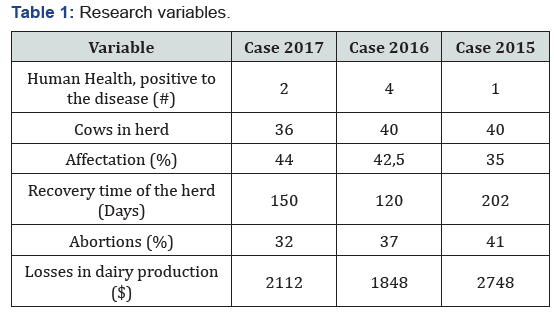Economic Affectation by Brucella Abortus in Dairy Farms, High Andean Case Report in Ecuador
Carrasco Robinson1*, Castro Walter1, Guaman Santiago2 and González Raúl1
1Escuela Superior Politécnica de Chimborazo (Ecuador), Spain
2Universidad Autónoma de Barcelona (Spain), Research Group on Ruminants (G2R), Spain
Submission: June 26, 2019; Published: July 10, 2019
*Corresponding author: Carrasco Robinson, Escuela Superior Politécnica de Chimborazo (Ecuador), Orellana, Zootecnia, Spain Dairy and
How to cite this article: Carrasco Robinson, Castro Walter, Guaman Santiago, González Raúl. Economic Affectation by Brucella Abortus in Dairy Farms, High Andean Case Report in Ecuador. Dairy and Vet Sci J. 2019; 12(5): 555850. DOI: 10.19080/JDVS.2019.12.555850
Abstract
In Ecuador, three positive cases of bovine brucellosis were studied by Brucella abortus in three consecutive years (2015. 2016, 2017) in three different herds, in order to describe the potential affectation of this bacterium in the economy of the high Andean herds. , for which we went to the records of the three farmers, validated an instrument of information collection carried out as an interview, and took data from the Ministry of Agriculture regarding the prices of sales of animals in the period January 2015 December 2017, critical points are identified in the affectation that go from the imbalance between the sale of sick animals and the purchase of healthy animals of a similar level of production, towards the losses caused by reduction of volume of production during the quarantine, it is concluded that the high point of this affectation is in the loss of purchasing power of the ranchers in moments of maximum economic necessity and it is recommended to schedule among the organizations of the field the investigation of all the inherent aspects to the Brucellosis
Keywords: Brucellosis; Economic affectation; Quero
Introduction
Zoonotic diseases such as brucellosis are ongoing concern worldwide, both for public health problems, as well as the losses they cause in livestock systems and their impact on economic activity [1]. In the livestock context of the high Andean of Ecuador, the lack of control and prophylaxis programs for bacterial diseases becomes a predisposing environment for the incidence and prevalence of diseases such as brucellosis [2]. The economic losses in Latin America and the USA have been estimated by their respective governments at approximately 700 million dollars per year because of this disease [3]. The presence of bovine brucellosis in a dairy herd considerably increases the cost of production per liter of milk, resulting in higher expenses in health, food, losses due to animal deaths, discards and technical assistance [4].
The objective of this work was to estimate the economic impact of brucellosis by means of a study of three cases of cattle farms identified with seropositive of Brucella abortus affectation in high Andean region in Ecuador.
Materials and Methods
The case study was carried out in Zone 3, the central highlands of Ecuador with high Andean climatic characteristics at an average altitude of 3000 masl, records were taken in three farms affected by the disease with a different year of registration, data was taken from the official site of the Ministry of Agriculture[5] regarding the sale price of animals (cows) for the years 2015, 2016 and 2017 to reference the local context and the economic impact. For the evaluation of information in the field, a group of experts in Bovine Production and Health from the Ministry of Agriculture validated an instrument for gathering information that meets the research objectives regarding economic information. In addition, a T-test was used. average contrasted with the values of each year of affectation of the producers under study, for the data processing the statistical package Info stat version 2017 was used.
Result and Discussion
Table 1 note that the recovery times of the herds in days, in summary from detection to complete sanitation, is at least 4 months. This is also indicative of the bureaucratic problem that surrounds the process. The results regarding economic losses coincide with previous studies [3,4], which also detailed that in the central zone of Ecuador small herds with less than 10 animals require the rental of grazing surfaces, so they must be constantly mobilized and have positive reactors to the disease are a latent vector not monitored. Table 2 shows the values registered during each year by the Ministry of Agriculture on the sale price of standing animals ($ / kg), for the test were considered average cows of 450kg in all scenarios, in a T-test of an average with respect to the average sale price of the cows confirmed by the Laboratory in each livestock, and in a second scenario the price of acquisition of animals of the same productive tenor, the contrast of the average prices for each animal group showed highly significant differences of the record of price in places of trace at national level [5].


Price registered by MAGAP
The producer during the sanitation of his livestock loses purchasing power due to the sale of positive reactors, due to the decrease in the volume of milk generated during the quarantine, the expenses in health, the time taken for the total recovery of the herd depends directly on the economic capacity of the rancher. This agrees with [4], who mention that a positive animal sent to the slaughter plant is sold by weight at the price of the meat at that time, thus losing the added value derived from its genetic and productive potential. it can rise significantly in favor of the rancher’s economy.
Conclusion
The main point of economic affectation of bovine brucellosis in dairy farms in the county Quero province of Tungurahua, studied the markets and compared with the three cases in research, is the imbalance between the sale price of sick animals and the purchase price of animals healthy from a similar level of production, with statistical differences to the annual averages registered by the Ministry of Agriculture, and additionally, the losses caused by reduction of milk production volume, during the quarantine this generates loss of purchasing power and need of indebtedness to the ranchers.






























